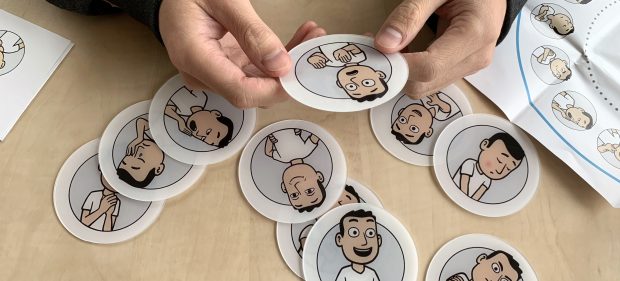Introduction
Being human is being emotional. Emotions are central to our existence because they influence and enrich all of our thoughts and activities. But how can they be measured? Even though we experience many emotions every day, it is often difficult to find the right words to communicate them. Filling out emotion questionnaires can therefore be quite a challenge.
At the same time, we are experts in recognizing the emotional expressions of other people. What if you could just point out emotions to communicate how you feel? This is the idea that inspired Premo: A pictorial emotion scale.
Premo
The heart of Premo is a cartoon character that uses her/his face, body and voice to express fourteen different emotions. Half of these are positive, like pride and joy. And the other half are negative, like fear and sadness. Together, these 14 emotions represent a solid cross-section of the human repertoire.

Fourteen of Premo expressions

Male and female Premo characters
How Premo works
With Premo, people can report their feelings in any situation by simply pointing out one or more cartoons. You can measure the emotions people have towards new designs, medical procedures, during a music festival, when tasting wine, or in any other situation you are interested in. Premo makes the measurement of both strong and subtle feelings simple and reliable. Because it does not rely on words, Premo supports cross-cultural research. The animations have been validated in many countries across the world (see Laurans and Desmet, 2017).
You can use the online version for large-scale (quantitative) studies, or the card-set for (qualitative) interview sessions.
Measuring emotions with Premo
Four key Premo benefits
- High sensitivity
The majority of people’s emotions are of low intensity. Premo is much better able to measure these subtle and low-intensity emotions than do verbal questionnaires or bodily measurements.
- Multiple emotions
Most situations and designs do not evoke a single emotion, but a combination of different, sometimes even opposite emotions. PrEmo reveals the mixed and complex emotion profiles of products, locations, services, and situations.
- Cross-cultural validity
Premo has been extensively validated across cultures. Validation studies have shown that PrEmo can be used cross-culturally and by all ages to deliver rich and reliable data.
- Flexible application
Premo works for qualitative and quantitative research, and can be customized to your research purpose. Premo is available with a male and a female character.
Availability
For academic research, an offline (paper) Premo version is available. You can download the material here:
Premo is published under an Attribution-NonCommercial-NoDerivatives 4.0 International Creative Commons licence (CC BY-NC-ND 4.0). This means that you are free to use the tool for non-commercial purposes as long as you give appropriate credit, provide a link to the license, and do not modify the original material.
For non-academic (commercial) usage, Premo is made available by Emotion Studio (including the online version):
www.emotion.studio/tools/premo
www.premotool.com
Tips on using Premo
The Premo characters can be used in interviews, focus groups, or any other conversation in which you want to address or talk about feelings. You can ask your respondent(s) or conversation partner(s) to pick one or more Premo characters to express their feelings.
You can ask them how they feel about a particular stimulus, such as a product design, an image, a fragrance, an interior, a service encounter, and etcetera. Likewise, you can also ask them what they would like to feel, what they are not feeling, what they felt in previous events, or what they expect to feel in future events.
Examples of questions/tasks you can use in interviews or focus groups:
– Select one or more cartoon that best express how you feel.
– Place order the cartoons to express how strong your feelings are.
– Explain in your own words what the cartoon expresses.
– Explain why you feel this way.
The design has been kept simple to support usage versatility. The characters are basically self-explanatory, but if you want you can introduce and discuss them at the start of your conversation.

Premo in action
Authors
Premo was conceptualized and developed by Pieter Desmet (TU Delft). Animated cartoons were created by Peter Wassink. The online platform was developed by Steven Fokkinga and Willem van der Maden (Emotion Studio). Validation studies by Pieter Desmet and Gael Laurans (TU Delft).
Citation
In communication, please refer to PrEmo as follows: Desmet, P.M.A. (2019). PrEmo card set: Male version. Delft, Delft University of Technology. ISBN: 978-94-6384-076-7.
References
Desmet, P.M.A. (2018). Measuring emotion: Development and application of an instrument to measure emotional responses to products. In: M.A. Blythe & A.F. Monk (Eds.), Funology 2: from usability to enjoyment (pp. 391-404). Springer Publishing.
<downloadable pdf>
Laurans, G., & Desmet, P.M.A. (2017). Developing 14 animated characters for non-verbal self-report of categorical emotions. Journal of Design Research, 15(3/4), 214-233.
<downloadable pdf>
Desmet, P.M.A., Porcelijn, R., & van Dijk, M.B. (2007). Emotional design: Application of a research-based design approach. Journal of Knowledge, Technology & Policy, 20(3), 141-155.
<downloadable pdf>
Desmet, P.M.A., & Dijkhuis, E.A. (2000). A wheelchair can be fun: a case of emotion-driven design. In: DPPI 2000; Proceedings of the International Conference on Designing Pleasurable Products and Interfaces, June 23-26, 2003. Pittsburgh, PA, USA, (pp. 23-26). New York, NY: ACM Press.
<downloadable pdf>
Desmet, P.M.A., & Schifferstein, N.J.H. (2012). Emotion research as input for product design. In J. Beckley, D., Paredes, & K. Lopetcharat (Eds.), Product Innovation Toolbox: A Field Guide to Consumer Understanding and Research (pp. 149-175). Hoboken, NJ: John Wiley & Sons.
<downloadable pdf>
Publication date
Various versions between 2002 and 2021
Contact
p.m.a.desmet@tudelft.nl



